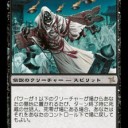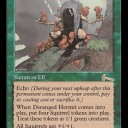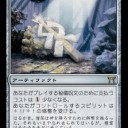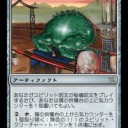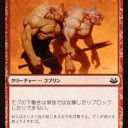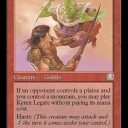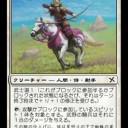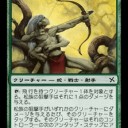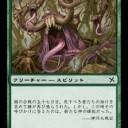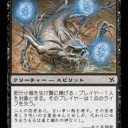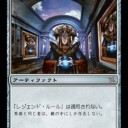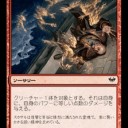神河当時 - 文化的背景:狐
2021年5月29日 Magic: The GatheringThe Kitsune
Messengers of the Gods: The white kitsune of Kamigawa are based on the "Inari kitsune," the fox spirits that act as messengers and couriers for Inari, the kami of the rice fields. Shrines to Inari are still commonplace in Japan, even in Tokyo where you’ll find them wedged in between the high-rise buildings. You can tell an Inari shrine immediately by the stone fox statues on either side of the entrance. Here’s an example from an Inari shrine near me:
The shrines serve as a convenient place to pay respect to the natural world and the kami governing things like crops and rain. When a petitioner comes to the shrine to ask Inari for a good harvest, it is the fox who accepts the offering (traditionally a gift of food and money) and takes it to the kami on man’s behalf.
The Many Colors of Kitsune: Kamigawa’s foxes weren’t always white. In the initial stages of world development, there were a number of ideas for kitsune of different colors. Shape-changing foxes (bakegitsune), who appear in some of the earliest recorded folktales in Japan, would have fit comfortably into a blue role, while the wild fox-spirits (nogitsune), known for creating illusory banquets out of garbage in abandoned temples made to look like fabulous palaces could have evolved into a blue illusionist kitsune, or even a malicious black kitsune--though there they would run into competition from fox-mages (kitsune-tsukai) who command evil fox-spirits to steal from others, or the dreaded possessing foxes (tsukimono-gitsune) who possess people and make them do malicious things like eat other people’s rice cakes. Suffice it to say there was a lot to choose from, though I think that the white kitsune rose to the top as they best represent the dilemma of Kamigawa’s mortal inhabitants: once servants of the kami, they seem closer to the spirit world than their human counterparts, yet tragically they are forced by the war to defend themselves against their former masters or perish.
Whence the Tails?: We already know how Eight-and-a-Half-Tailsgot his tails, but why should foxes have any business running about with more than one tail, anyway? It turns out that there was a long-standing belief in some circles of the Imperial court that the appearance of a kyubi-kitsune (nine-tailed fox) was a good omen for the reign of the current Emperor. Indeed the earliest court documents in Japan mention seeing this strange creature frolicking around on the palace roof at the beginning of a new Emperor’s reign in a sort of Imperial publicity stunt. Though not directly related to the Inari kitsune, the nine-tailed fox is traditionally white in color--tailor-made for inclusion with the kitsune of Kamigawa.
引用元
TRUTH IN FANTASY Posted in Feature on March 7, 2005
https://magic.wizards.com/en/articles/archive/truth-fantasy-2005-03-07
神河のモチーフである、日本神話や民間伝承について解説した記事です。長いので、分けて取り上げてみましょう。
まずは狐です。最初に、「神々の使者」としての側面があります。日本に、狐が祀られている「稲荷神社」が少なくないことがその表れでしょう。
また、最初は、神河の狐は白だけではありませんでした。民間伝承では狐がさまざまな姿に変化する様子は、青に相応しいでしょう。また、廃寺で宴を開く野生の狐の精は、青の狐・イリュージョンになっていたかもしれない、とのことです。他にも、悪い狐の精に命じて人のものを盗む狐使いや、人に憑依して悪事を働く狐など、日本民話にはさまざまな狐が語られています。最終的に狐が白だけになったのは、神河においては、何よりも神との繋がりを重視して「神に仕えるもの」という点が理由のようです。
宮廷の一部では、九尾の狐が現れることは天皇の治世にとって吉兆であるという考えが古くからありました。それゆえに、神河の狐には複数の尻尾を持つようになったようです。和風モチーフの創作物では「九尾の狐」は定番ですが、このような謂れは初めて知りました。また、この「九尾の狐」が白であることも、神河の狐が白単色である理由の一端のようです。
Welcome to another edition of Sketches! Few cards express the Kamigawa block’s spirit-vs.-mortal theme as well, in both mechanic and art, as Betrayers of Kamigawa’s Clash of Realities. Today we take a look behind the scenes of the illustration of this evocative card. But first, some background on the artist, Jim Nelson.
Artist Portfolio
Artist Jim Nelson has contributed over seventy pieces of Magic card art since Tempest. You can see his work on such cards as Benthic Behemoth, Cataclysm, Replenish, Fungal Shambler, Grim Lavamancer, Cunning Wish, Hunting Pack, the Mirrodin spellbombs, and the Swamp, among many others.
Art Description
The first step of the creation of a card’s art is its art description. The art description tells the artist what the card will do, what its flavor is, and what the mood of the illustration should be. Here were the instructions given to Jim for Clash of Realities:Color: Red spirit-world magic
Location: red-aligned location of artist’s choosing
Action: Show a yamabushi and a red-aligned kami of your design locked in combat. A fissure has just begun to open beneath them, spitting droplets of magma on the surrounding ground.
Focus: The impending death of both creatures
Mood: "If I’m going down, so are you!"
The next step is for the artist to submit sketches of his or her vision of the art description.
引用元
SKETCHES: CLASH OF REALITIES Posted in Arcana on March 7, 2005
https://magic.wizards.com/en/articles/archive/arcana/sketches-clash-realities-2005-03-07
《現実の激突/Clash of Realities》のスケッチを解説した記事です。
「神 vs 定命」が神河ブロックのテーマです。このカードは、それをメカニズムでもイラストでも表すものとして、デザインされました。イラストレーターに提示されたコンセプトもそのようなものであり、初稿でほぼ完成と言えるほどに文句のつけようのないものだったようです。
神河当時 - リミテッドにおける青赤
2021年5月27日 Magic: The GatheringWhenever you sit down across from a player who is piloting a two-colour deck you will normally find that they are playing two allied colours. It’s not surprising of course, as the allied colours tend to have more in common than the opposing colours do and blue-white or red-green (for example) tend to just work better than other misaligned combinations.
In this block more than in previous ones we’ve seen the rise of several opposing colour combinations. Black-green can frequently be successful when focused on Spirits and Soulshift backed up by Devouring Greed. I’ve also discussed the white-red aggro-Samurai deck that is the preferred deck amongst some players. Today though I’m going to be tackling what is probably the most commonly drafted opposing colour combination: blue-red.
As colours go you don’t get much more opposite than blue and red. In the most basic terms of what these colours stand for you have chaos vs. planning and freedom vs. control. Red wants to be aggressive and attacking all the time; blue wants to be a bit more controlling and take things slower. It’s obvious to anyone that you wouldn’t expect these two colours to cooperate but in this block they frequently do. This isn’t the first time that we’ve seen this particular combination rise in popularity of course; I seem to remember a little card called Lavamancer’s Skill that was quite popular a couple of years ago.
Just as the card Lavamancer’s Skill was primarily responsible for the strength of the blue-red archetype in the Onslaught Block, we now have another red card – Glacial Ray – which is responsible for a lot of the power of blue-red in the Champions block limited format. The situation in Champions block is a little different in that Glacial Ray is far more playable in other colour combinations than Lavamancer’s Skill was. It wasn’t uncommon to get Lavamancer’s Skills quite late in a triple-Onslaught draft if the other players were already entrenched in red-green or red-black. That obviously doesn’t happen with Glacial Ray however. Fortunately there are a few other strategies you can employ if you find yourself in a position to draft this combination that will still let you win even if you aren’t able to get those Glacial Rays that this deck really benefits from.
引用元
WHEN OPPOSITES ATTRACT Posted in Limited Information on March 7, 2005
https://magic.wizards.com/en/articles/archive/limited-information/when-opposites-attract-2005-03-07
リミテッドにおいては、通常、友好2色でデッキを組むことが多いが、神河においては、対抗2色で組むことが珍しく無くなった、ということで、特に、青赤のデッキを特集しています。対抗2色の例は、転生なら黒緑、侍なら白赤で組むことができます。最近は、友好でも対抗でも対等に扱い、リミテッドでは10通りのアーキタイプが組めるようにデザインする方針なので、隔世の感があります。
青赤の場合、これらのクリーチャー主体のメカニズムではなく、秘儀・連繫によるアドバンテージを狙ったデッキです。この点では、最近と同様にスペル主体になっているのが、やはりこの2色のイメージとして強固なものということの表れでしょうか。
もともと連繫自体が特定のカードを集めるように仕向けるメカニズムであり、《禍御鳴の激憤/Ire of Kaminari》という分かりやすいカードもあります。また、スタンダードやブロック構築でも青赤連繫デッキは存在できたほどにはパーツがあるので、リミテッドでは自然と成立できたのでしょう。
神河当時 - ルールQ&A 2005/03/05
2021年5月26日 Magic: The GatheringQ: What happens if I have Shirei, Shizo’s Caretaker and a Deranged Hermit in play and I don’t pay the Hermit’s echo? --Ruediger D.
A: The Hermit will be put into the graveyard because you didn’t pay the echo, and Shirei will trigger. At the end of your turn (assuming Shirei is alive and well), your Hermit will come back and bring along four new Squirrel friends.
引用元
MANY QUESTIONS AND ONE PROPOSAL Posted in Feature on March 5, 2005
https://magic.wizards.com/en/articles/archive/feature/many-questions-and-one-proposal-2005-03-05
恒例のQ&A記事です。
《死蔵の世話人、死零/Shirei, Shizo’s Caretaker》と《錯乱した隠遁者/Deranged Hermit》でリスを大量生産するコンボが目に止まりました。『モダンホライゾン2』のレビューでリスが1つのテーマとして取り上げられることが分かったから、というだけのことなのですが。
Artifactorial
Scott Johns informs me that it’s Artifact Week, which is odd, because it’s not that far removed from Artifact Year. So it’s my task to present some interesting artifact-based decks that I didn’t already talk about during Artifact Creature Week, Machine Week, any of the 52 weeks of Mirrodin block, or any other week I’ve been writing this column.
Ri-i-i-ight.
Oh, but there’s always more stuff out there. In fact, there’s a nutty little cross-Kamigawa artifact interaction that just became possible to play on Magic Online now that Betrayers is on there: Long-Forgotten Gohei and Baku Altar.SPIRIFACT
Sorcery (2)
2 Eerie Procession
Instant (18)
4 Consuming Vortex
2 First Volley
4 Glacial Ray
4 Peer Through Depths
4 Reach Through Mists
Artifact (16)
4 Baku Altar
4 Isochron Scepter
4 Jade Idol
4 Long-Forgotten Gohei
Land (24)
8 Island
8 Mountain
2 Blinkmoth Nexus
3 Mirrodin’s Core
3 Tendo Ice Bridge
60 Cards
引用元
HITCHHIKING ON COATTAILS Posted in Feature on March 3, 2005
https://magic.wizards.com/en/articles/archive/hitchhiking-coattails-2005-03-03
アーティファクト・ウィーク、という訳ではないですが、アーティファクトに注目してデッキを組もう、という話で、神河の《獏の供犠台/Baku Altar》と《遥か忘れられし御幣/Long-Forgotten Gohei》デッキが紹介されています。
《獏の供犠台》はスピリットクラフトで、スピリット・トークンを生成する一方で、《遥か忘れられし御幣》はスピリットクラフトを誘発する秘儀のコストを下げ、スピリットクラフトで生成したトークンを強化する、という抜群の相性の良さです。
誘発条件と、誘発による効果の両方をサポートする。コンボを意図したデザインなのかは分かりませんが、このようなデザインは面白いと言えます。
神河当時 - 『神河救済』のロゴのコンセプト
2021年5月24日 Magic: The GatheringWe’ve already shown you the logo and expansion symbol for Saviors of Kamigawa, the Kamigawa block’s final set, coming in June. Today we’d like to take a moment to go behind the scenes to show you some of the evolution of that Saviors’ logo and symbol.
To the right you can see a couple other potential designs for the Saviors of Kamigawa expansion symbol. The one at the bottom is the final design.
Here are preliminary logo designs and some packaging mockups based on them.
More packaging mockups with the logo finalized. Note even more ideas for expansion symbols here, and some interesting variations in background.
引用元
SAVIORS LOGO CONCEPTS Posted in Arcana on March 2, 2005
https://magic.wizards.com/en/articles/archive/arcana/saviors-logo-concepts-2005-03-02
『神河救済』のロゴが、どのように変わっていったのか、が分かる記事です。とは言っても、ロゴというよりは、その横に添えられたエキスパンションシンボルの方が変化としては目立つのですが。
一番目の柄の長い武器、三番目のトンボ、最終的な灯籠は分かるのですが、二番目と四番目についてはよくわかりません。
トンボは、何を描いたものか分かりやすいのはいいところです。ただ、そのセットを象徴するものかと言われると疑問です。あるいは、開発中では、それが何かしら意味のあったものなのかもしれませんが。
「救済」の名の通り明るい将来を示すものであり、和風である、灯籠なのはそれなりに納得いく落とし所ではないでしょうか。
March 31, 2005
Q: "Why does the wording on the Ember-Fist Zubera not match the other four cards in the Zubera cycle?"
--Matt Cincinnati, Ohio, USA
A: From Del Laugel, Magic Senior Editor R&D:
"The other four cards in this cycle (Ashen-Skin Zubera, Dripping-Tongue Zubera, Floating-Dream Zubera) have effects that happen ’for each Zubera put into a graveyard from play this turn.’ But as Matt points out, Ember-Fist Zubera is worded differently: ’it deals damage to target creature or player equal to the number of Zubera put into all graveyards from play this turn.’ Why isn’t this one like the others?
"The difference is that Ember-Fist Zubera deals damage. Any effect that deals damage is templated so that the damage is dealt all in one clump. This makes everything interact sensibly with damage-prevention effects like Circle of Protection: Red and Opal-Eye, Konda’s Yojimbo that check for ’the next time’ a source would deal damage.
"With that in mind, Mana Clash stands out as the real oddball in the Magic universe. It’s both the only spell that requires multiple Circle of Protection activations and the only coin-flip card that doesn’t let a player call the flip."
引用元
ASK WIZARDS - MARCH, 2005 Posted in Feature on March 1, 2005
https://magic.wizards.com/en/articles/archive/ask-wizards-march-2005-2005-03-01
ずべらサイクルは、「このターンに死亡したずべら1つにつき」という書き方なのに、《燃えさし拳のずべら/Ember-Fist Zubera》だけは、「このターンに死亡したずべらの数に等しい点数のダメージを与える。」という書き方なのはなぜか?という質問です。
防御円や《今田の用心棒、乳眼/Opal-Eye, Konda’s Yojimbo》などの「次の」ダメージが与えられることに関する効果の挙動を機能させるため、ということです。これはずべらに限ったことではなく、基本的な方針とのことです。その数少ない例外が《魔力激突/Mana Clash》ということも挙げられています。
March 22, 2005
Q: "I understand it’s important to let the artists go with their strengths, but do you ever give artists pieces you know they don’t prefer, simply to see what they are capable of? If so, could you let us know what some of these pieces have been that worked out well in the past?"
--Craig
Aloha, OR, USA
A: From Jeremy Cranford, Magic Art Director:
"Hi Craig,
"That is a very good question. What kind of art director would I be with out challenging the artists?
"Yes, I do try and give artists pieces that I know they’ll have to stretch in order to make them work. Using two current examples, the first would be the Kamigawa swamp mural by Jim Nelson. He doesn’t paint landscapes and I wanted to see how he’d handle a non-figurative assignment, and I think the final piece came out great. Then there was the Hana Kami in Champions of Kamigawa by Rebecca Guay. Rebecca is very good with figures but was a bit surprised when I assigned her an abstract Kami concept. It was a stretch from her normal work but again I think it turned out great.
"There are times when I’m not so lucky but I won’t talk about those :)"
引用元
ASK WIZARDS - MARCH, 2005 Posted in Feature on March 1, 2005
https://magic.wizards.com/en/articles/archive/ask-wizards-march-2005-2005-03-01
アーティストの力を引き出すために、あえて苦手なもの描かせることがあるか?という質問です。
アーティストディレクターだから、そうすることはある、という回答です。その一例が、風景画を描かないJim Nelsonに描かせた『神河物語』の《沼/Swamp》であり、造形が得意なRebecca Guayに描かせた抽象的な神の《花の神/Hana Kami》ということでした。これらは、アーティストが見事にその力を引き出した成功例と言えます。
March 21, 2005
Q: "In the other sets all the goblins pretty much had the same look. Then Champions came out and the goblin race got a makeover! Why did you change the look of the goblins for the Kamigawa Block?"
--Chris Morewood
Girard, Pennslyvania, USA
A: From Brady Dommermuth, Magic Creative Director:
"All goblins look the same, Chris? Mogg Flunkies are hulking, no-necked thugs. Kyren Legate are practically aristocratic -- they look almost like short elves with green skin. In our minds, goblins have varied pretty widely from setting to setting, so the Akki Underminer didn’t seem like much of a stretch to us. But back to your question: Almost everything in Kamigawa has some connection to Japanese myth or folklore, and that folklore doesn’t really have any goblins, per se. In looking for a Japanese equivalent to goblins, concept illustrator Ittoku came up with an idea based on another mythological creature: the kappa. He drew a little, shelled goblin-like thing and scrawled ’FIRE KAPPA’ next to it. We thought it suited the goblin ’ethos’ quite well, and thus the akki were born."
引用元
ASK WIZARDS - MARCH, 2005 Posted in Feature on March 1, 2005
https://magic.wizards.com/en/articles/archive/ask-wizards-march-2005-2005-03-01
今までのゴブリンは似たような見た目をしていたのに、悪忌だけ全然別物にしたのはなぜか?という質問です。
そもそも、今までのゴブリンでさえ、同じではない、というのが回答です。《モグの下働き/Mogg Flunkies》は大柄なチンピラ、《カイレンの使節/Kyren Legate》は背の低い貴族、といったように。それゆえに、《悪忌の蝕み屋/Akki Underminer》をゴブリンというのも、開発者側は無理があるとは思っていないようです。
神河のゴブリンの見た目について言えば、日本神話や民話にそれらしい種族を探したがいいものが見つかりませんでした。そこで、一徳がカッパをモチーフにするアイデアを出し、採用されました。今までのゴブリンとはかなり外れたデザインコンセプトであるため、「見た目が変わった」と感じること自体は無理からぬことだと思います。
March 18, 2005
Q: "Why is Goblin Cohort not ’Akki Cohort’? I thought all goblins were akki in Kamigawa?"
--Blair
Birmingham, AL
A: From Brandon Bozzi, Magic R&D:
"Thanks for the question Blair. The simple answer is all goblins in Kamigawa are akki, this one just doesn’t happen to have akki in its name.
"We’ve done goblins in the past with a similar naming convention. Remember moggs? Some of them have ’goblin’ in their name and some do not. For example, both Raging Goblin (Exodus) and Slingshot Goblin are moggs. So, when we introduce a new species of goblin, whether it be moggs, or Kyren Glider, or akki, the name of the species and ’goblin’ are both fair game for card names."
引用元
ASK WIZARDS - MARCH, 2005 Posted in Feature on March 1, 2005
https://magic.wizards.com/en/articles/archive/ask-wizards-march-2005-2005-03-01
神河ではゴブリンは「悪忌」と命名しているのに、なぜ『神河謀叛』の《ゴブリンの群勢/Goblin Cohort》は「ゴブリン」なのか、と言う質問です。
たまたま、と言うのが回答です。過去に「モグ」と言うゴブリンの一種がいたことを例にあげています。
モグ/Moggは、ファイレクシア/Phyrexiaによって戦闘、使役用に品種改良されたゴブリンの一種。主にテンペスト・ブロック、ネメシス、インベイジョン・ブロックに登場した。
一般的なゴブリンよりも大柄で力も強く、好戦的な性質で戦闘能力が高いが、同時に頭の悪さもパワーアップしてしまったらしく、とってもお馬鹿。
筋肉質、頭が尖っている、たいてい裸といった特徴から、イラストからは簡単にモグと普通のゴブリンとの判別ができる。
引用元
http://mtgwiki.com/wiki/%E3%83%A2%E3%82%B0/Mogg
《モグの狂信者/Mogg Fanatic》が特に有名でしょう。
しかし、これも常に名前に「モグ」と入っているわけではなく、《怒り狂うゴブリン/Raging Goblin》や《パチンコ・ゴブリン/Slingshot Goblin》は、名前がゴブリンですが、モグです。《ゴブリンの群勢/Goblin Cohort》もそのようなものだとのことです。
一理ある話です。ただ、神河に関して言えば、「悪忌」と「ゴブリン」と言うように漢字とカタカナですから、違和感が大きいです。英名でも、「Akki」という日本語の発音と「Goblin」という英語の発音では違和感があるでしょう。
他の部族で言えば、カード名では「空民」ですが、部族上は「ムーンフォーク」だからと言って、カード名に「ムーンフォーク」があったら、同じように違和感があるでしょう。こちらはそのようなカードは1枚もありませんでしたが。
March 17, 2005
Q: "I noticed that Betrayers of Kamigawa includes two creatures, Matsu-Tribe Sniper and Takeno’s Cavalry, that have creature type Archer. Previously, when creature types were being consolidated, a number of older creatuers, such as D’Avenant Archer and Longbow Archer, with creature type Archer were reprinted with creature type Soldier. Why the policy change? Are there any plans to make the old Archers back into creature type Archer?"
--Chris
Columbus, Ohio, USA
A: From Brady Dommermuth, Magic Creative Director:
"Chris, Magic’s creature types are -- how do I put this delicately? -- problematic. Little thought was given to them in the early days, then there were various attempts to clean them up. Some of these attempts were partially successful, some were, um, well intentioned. Then came Onslaught, which upped the stakes on the whole issue. The Onslaught block made players pay attention to creature type, and the flaws and weirdness became all the more apparent.
"One of the problems with creature types is that we’re very hesitant to change anything ’retroactively.’ In other words, now that we support the Archer type, it’s very unlikely that we’ll comb through the 10,000 distinct cards in Magic and put Archer on the ones for whom it makes sense. Instead we’ll simply apply Archer as appropriate going forward, and Magic’s past will remain the messy, patchwork beast that it’s been for many years. I know that may not sound ideal, but the alternative is far worse -- asking players to memorize Oracle from month to month so they can track the changes we’ve made."
引用元
ASK WIZARDS - MARCH, 2005 Posted in Feature on March 1, 2005
https://magic.wizards.com/en/articles/archive/ask-wizards-march-2005-2005-03-01
かつて《ダブナントの射手/D’Avenant Archer》や《長弓兵/Longbow Archer》はクリーチャー・タイプ「射手」を持っていました。しかし、再録された時に「兵士」になり、長らく「射手」が登場していませんでした。それが、『神河謀叛』の《武野の騎兵/Takeno’s Cavalry》や《松族の狙撃手/Matsu-Tribe Sniper》にて、射手が復活していることに気づいたので(※1)、なぜ方針転換したのか?前述のクリーチャーは射手に戻るのか?という質問です。
今後も射手は作っていくが、過去のクリーチャー・タイプを変更するのには躊躇している、という回答でした。
『オンスロート』で部族をテーマにして以来、クリーチャー・タイプが以前よりも注目されるようになったからこその流れです。「過去のを変更するのには躊躇する」とのことでしたが、この後には再び部族をテーマにした『ローウィン』でクリーチャー・タイプを大規模に再編しました。さらに最近では、過去のカードにクリーチャー・タイプを追加・変更することはさほど珍しくなくなっています。
こうした変化は、最新の情報をプレイヤーが入手しやすくなったこと、クリーチャー・タイプに人気が出てきたことなどが、要因でしょうか。
※1
質問者が気づいたのが神河だっただけで、実際には『ミラディン』の《テル=ジラードの射手/Tel-Jilad Archers》で復活していました。
March 16, 2005
Q: "Have there been other single artworks that have been split up and put on a number of different cards like Akroma and Phage, Tony Robert’s promotional lands etc., and what cards are they on? Do you commission the art intending to crop the image in different spots, or is the decision made after seeing the art?"
--Adam
Bathurst, Australia
A: From Jeremy Cranford, Magic Art Director:
"Hello Adam,
"I’m glad you notice these cards. They are planned and commissioned that way. There are lots of them around if you look. I think the first mural used for several cards were the "Ice Age" Plains land cards by Chris Rush. All of the basic lands were painted as one mural and then cropped into 4 cards. The forest painting by Rob Alexander was at least 4 feet long!
"There is the set of Nim zombie cards by Adam Rex, the Great Machine by Greg Staples and Steve Tappin, and the Brothers Yamazaki by Ron Spears.
"And that’s just a start, I’m sure there are more. I’m always looking for places to slip this sort of thing in when I can!"
引用元
ASK WIZARDS - MARCH, 2005 Posted in Feature on March 1, 2005
https://magic.wizards.com/en/articles/archive/ask-wizards-march-2005-2005-03-01
《怒りの天使アクローマ/Akroma, Angel of Wrath》と《触れられざる者フェイジ/Phage the Untouchable》のように、1枚のイラストを、分割して複数のカードにしたものはあるか?という質問です。
その回答で、例の1つとして、《山崎兄弟/Brothers Yamazaki》が挙げられていました。このようなイラストは、あらかじめそのような依頼をして、描かせているようです。機会をみて、こうしたカードはつくっていく、とのことでした。仮に神河に再訪することがあったとして、同じような分割イラストのカードが登場するか、楽しみです。
March 15, 2005
Q: "I noticed that in the Betrayers of Kamigawa art there are a lot of creatures with ’floating things’ hovering above them, usually numbering in 3s. All of the Baku have them, but so does Gnarled Mass and Bile Urchin. What is the flavor behind these floating things hovering around all of these spirits?"
--Tim
A: From Brady Dommermuth, Magic R&D:
"Glad you noticed, Tim. Early in Kamigawa world design, we weren’t sure whether all the kami would end up looking bizarre enough -- whether it would be clear that they’re otherworldly creatures. So we designed a ’visual cue’ -- a common element that all kami would share. The floating objects are that visual cue. Where did they come from? Concept illustrator Ittoku produced a sketch that would eventually become the Myojin of Cleansing Fire, and it had floating, flaming heads around it. (To see that early concept sketch, click here.) When a second concept illustration featured strange things floating around a central figure, we knew we had found our cue and ran with it."
引用元
ASK WIZARDS - MARCH, 2005 Posted in Feature on March 1, 2005
https://magic.wizards.com/en/articles/archive/ask-wizards-march-2005-2005-03-01
神(スピリット)のイラストにある、浮遊物は何なのか?という質問です。
これは、神が定命とは違うことを視覚的にも表すために導入されました。一徳(コンセプトイラストレーター)が《浄火明神/Myojin of Cleansing Fire》のスケッチを描いた時、火のついた頭部がその周囲に浮遊していたのをみて、これを他のスピリットにも使うことになった、という回答です。
なお、《節くれ塊/Gnarled Mass》や《胆汁小僧/Bile Urchin》のイラストから、浮遊物は3つであることが多い、と質問者は言っていましたが、回答では特に触れられていません。たまたま目についたのがそうだった、というだけでしょう。
2021/06/17追記
以下の記事では、そのスケッチを紹介しています。
ORIGIN OF "ENERGY OBJECTS" Posted in Arcana on March 15, 2005
https://magic.wizards.com/en/articles/archive/arcana/origin-energy-objects-2005-03-15
March 9, 2005
Q: "Why didn’t you make Mirror Gallery a Legendary Artifact?"
-- Martin
Adelaide, South Australia
A: From Henry Stern, Magic R&D:
"Thanks for the question Martin, we have certainly received this one a lot. If Mirror Gallery were a ’Legendary Artifact’ it would still be subject to its own rule. Thus the Legendary text would not mean anything. We felt this could confuse some people. ’Why does it say Legend, and then make the Legend rule not apply?’ In general, we like to remove all superfluous text from cards."
引用元
ASK WIZARDS - MARCH, 2005 Posted in Feature on March 1, 2005
https://magic.wizards.com/en/articles/archive/ask-wizards-march-2005-2005-03-01
なぜ《鏡の画廊/Mirror Gallery》を伝説にしなかったのか?という質問です。
仮に伝説であったとしても、自身のルールにより何の意味もなく、混乱させるだけである。ゆえに、余計なテキストは取り除こう、という理由だそうです。
とはいえ、伝説であることを参照するカードもあるのですから(特に神河)、厳密には何の意味もない、ということはありません。また、何の意味もない、というだけであれば、クリーチャータイプは意味がありません。ゲーム上は、参照するカードがあって初めて意味がありますし、参照するカードすらないものも多数あります。だからと言って、取り除くこともありません。フレイバーという側面もあるからでしょう。
こうした質問は多数あったそうです。それだけ、「これは伝説に相応しい」というイメージがあったのであれば、やはり伝説であった方が良かったのではないかと思います。
March 3, 2005
Q: "My question has to do with the flavor behind the card Final Judgment. The card itself features O-Kagachi, the kami that all other kami came from. Because I don’t believe that R&D would have missed this, I ask what the reason was behind keeping the card from being Arcane?"
--Tony
Chandler, Arizona, USA
A: From Brady Dommermuth, Magic Creative Director:
"Tony, the Arcane subtype represents spirit-world spells -- magic wielded by the kami. Final Judgment shows a great kami, but it’s not meant to represent spirit-world magic, but rather a spell that recreates a pivotal moment in the Kami War. O-Kagachi isn’t just the kami of all kami. It’s the very embodiment of the barrier between the utsushiyo and the kakuriyo, the living essense of the difference between the two worlds. So when the O-Kagachi is directly involved, distinctions between the material and spirit worlds blur almost to meaninglessness. And the more those distinctions blur, the more angry and unstable O-Kagachi becomes."
引用元
ASK WIZARDS - MARCH, 2005 Posted in Feature on March 1, 2005
https://magic.wizards.com/en/articles/archive/ask-wizards-march-2005-2005-03-01
WotCに送られた質問に答える記事"ASK WIZARDS"の2005年3月分から、神河関連のものを見ていきます。
《最後の裁き/Final Judgment》は神である「大口縄/O-Kagachi」がイラストに出ているのに、なぜ秘儀ではないのか?という疑問です。
ここでの回答は、秘儀は神(スピリット)の世界の魔法を表すものであり、《最後の裁き》は神の乱の重要な場面を再現するものであるから、両者は異なる、ということでした。
また、大口縄は神の世界と定命の世界との境界を体現した存在であるため、大口縄が関与することはどちらの世界のことと区別できない、という説明もされています。
今まで、MTG wikiに書かれていた「シナジーが強すぎる」というパワーバランス上の理由しか知らなかったので、こうしてフレイバー面からの理由を知ることができたのは収穫でした。
大口縄が最後の裁きを下すのだと思われるが、その割にこのカードは秘儀ではない。
実は秘儀にする案もあったのだが、黄昏の守護者、秘加理/Hikari, Twilight Guardianとのシナジーが強烈過ぎるので却下となった(参考)。
引用元
http://mtgwiki.com/wiki/%E6%9C%80%E5%BE%8C%E3%81%AE%E8%A3%81%E3%81%8D/Final_Judgment
Okiba-Gang Shinobi
Betrayers of Kamigawa common. It probably comes as quite a surprise when that seemingly-innocuous Birds of Paradise or Ornithopter suddenly turns out to be a humanoid rat that’s been trained in the deadly arts. That would be startling enough to make anyone lose some cards.
引用元
CARD OF THE DAY - MARCH, 2005 Posted in Feature on March 1, 2005
https://magic.wizards.com/en/articles/archive/card-day-march-2005-2005-03-01
《極楽鳥/Birds of Paradise》や《羽ばたき飛行機械/Ornithopter》が、いきなり暗殺ネズミに化たら驚くでしょう、という話です。《大牙の衆の忍び/Okiba-Gang Shinobi》がテーマですが、どの忍者カードでも言えることでしょう。もっとも、それらのパワー0の飛行クリーチャーと組み合わせて忍者が活躍していたのも事実ですが。
Ember-Fist Zubera
Champions of Kamigawa common. The first Zubera, this one was so popular that it ended up inspiring an entire cycle. Interestingly, all of the Zubera were 1/1’s for 2 mana, but they proved to be ridiculous with Skullclamp (still legal at that time) so each was given an extra toughness to make them worse!
引用元
CARD OF THE DAY - MARCH, 2005 Posted in Feature on March 1, 2005
https://magic.wizards.com/en/articles/archive/card-day-march-2005-2005-03-01
《燃えさし拳のずべら/Ember-Fist Zubera》が一番最初に作られました。これが人気を得たことで他にもずべらが作られ、サイクルになった、という話です。
また、元々は2マナ1/1だったのですが、あの《頭蓋骨絞め/Skullclamp》との相互作用が強すぎる、ということでタフネスが増えました。ずべらは大体サクリ台を使って同時にサクる方が強力なため、タフネス強化はさほど弱体化とも言えないでしょう。そもそも《頭蓋骨絞め/Skullclamp》が強すぎることにはもっと早く気づけなかったのか?と言いたくなってしまいます。
Kiku, Night’s Flower
Champions of Kamigawa rare. This card was designed by concept first: an assassin that killed by animating the victim’s shadow. Though the resulting ability ended up being an effect normally associated with white (see Repentance), the flavor of the card was still a fine fit for black.
引用元
CARD OF THE DAY - MARCH, 2005 Posted in Feature on March 1, 2005
https://magic.wizards.com/en/articles/archive/card-day-march-2005-2005-03-01
《夜の華、切苦/Kiku, Night’s Flower》は、「標的の影を操って仕留める暗殺者」というフレイバー先行でデザインされました。かつては《悔恨/Repentance》など、白の能力だったのですが、雰囲気としては黒にも通ずるところがある、とのことでこうなったようです。また、後の『神河救済』で、起動型能力をスペルにした《切苦の影/Kiku’s Shadow》が登場しました。
その後、赤のカード《狂気の残骸/Wrack with Madness》として、また担当する色が変わりました。真木孝一郎氏はこのことを「落ち着きの悪い」と表現しています。
ただ、色の役割で共通する部分が多いこともあります。特に最近の顕著な例は、黒のエンチャント除去です。アーティファクト除去が白緑赤とあって、エンチャントが白緑だけ、という点から、バランスを考えて黒にも作られるようになりました。この、「自身のパワーに等しいダメージを与える除去」にしても、それと同様と言えるかもしれません。単体除去呪文は白黒赤の役割ですから、その中で共通の除去手段がこれだった、と考えています。
Azusa, Lost but Seeking
Champions of Kamigawa rare. During design this card originally allowed you to play as many lands as you wanted in a turn, but this quickly proved to be way too good in combination with the Soratami abilities (among other things).
引用元
CARD OF THE DAY - MARCH, 2005 Posted in Feature on March 1, 2005
https://magic.wizards.com/en/articles/archive/card-day-march-2005-2005-03-01
日替わりで1枚のカードを取り上げるコラム「CARD OF THE DAY」の2005年3月分から、1枚ずつ見ていきます。
《迷える探求者、梓/Azusa, Lost but Seeking》は、開発中、1ターンに望む数だけ土地をプレイでき他のですが、他の能力との組み合わせが強すぎることが分かり、制限がかかったようです。それでは、《Fastbond》の二の舞ですから、当然の結果としか言いようがありません。
The Betrayers of Kamigawa card Twist Allegiance is a spell that causes creatures to desert their masters and defect to the enemy side. The art by Wayne Reynolds shows a chaotic, pitched battle between mortals and spirits in which a huge, angry spirit looms above the battlefield:
Twist Allegiance
Who’s that roaring kami?
Do you recognize that roaring kami in the upper left? Want a hint? (Show the answer. Hide the answer.)
Myojin of Infinite Rage
Why, it’s the Myojin of Infinite Rage! No surprise he enjoys a chaotic tussle now and again, what with all that infinite rage and all.
引用元
WHO’S THAT SPIRIT? Posted in Arcana on March 1, 2005
https://magic.wizards.com/en/articles/archive/whos-spirit-2005-03-01
《よじれた忠義/Twist Allegiance》のイラストの解説です。
このカードは、クリーチャーが主君を捨てて敵側につくことを表している効果です。そのイラストの左上に描かれているスピリットは、《激憤明神/Myojin of Infinite Rage》であり、この混沌とした戦いを楽しんでいます。
秘儀ではないので、彼自身はこの混沌を作ったのではなく、あくまでも楽しんでいるだけ、と考えられます。ただ、《最後の裁き/Final Judgment》のように、シナジーなどの観点から秘儀でない可能性もあります。



